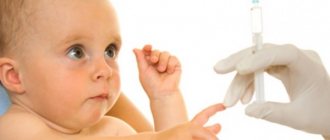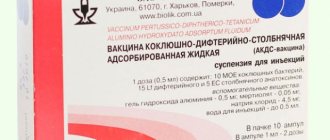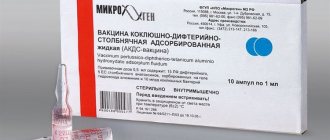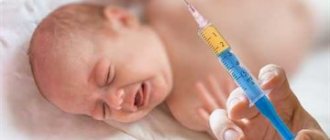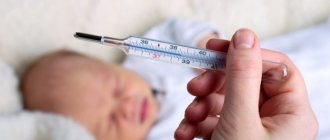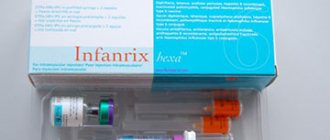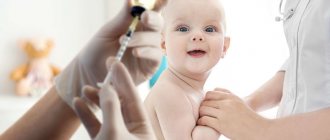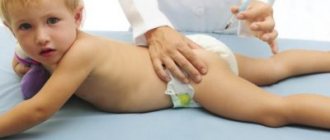Good afternoon, dear parents! Have you given your child the DPT vaccine? Judging by my experience, and by numerous publications and reviews on the Internet, it is she who brings fear to everyone and everything. And with good reason. Doctors do not deny that DPT has a high rate of complications, a number of contraindications and side effects and requires serious preparation before its administration.
But at the same time they insist that it protects against the most dangerous infectious diseases. So, to be or not to be? This is exactly what we will help you deal with.
So, DTP vaccination - what is it, why is it needed, is it possible to do without it and, if not, then how to vaccinate without harming it? Especially for readers of our blog, we have found answers to the most popular questions about DTP and are in a hurry to share them.
Explanation of DTP vaccination
The letters in the name of the vaccine are the names of the diseases from which you need to protect yourself: whooping cough, diphtheria and tetanus. And the first letter “A” means adsorbed vaccine.
To prepare a vaccine, toxins from microbes that cause disease are processed in a certain way in laboratories. The processing process produces toxoids. This means that the toxic properties of pathogens are suppressed, but are still capable of inducing the production of antibodies and forming immunity to these diseases.
The DTP vaccine contains the following components:
- killed pertussis toxoids;
- 30 units of purified tetanus toxoid;
- 10 – diphtheria;
- aluminum hydroxide, on which pathogens are sorbed;
- special mercury-containing preservative, 50 mcg per dose.
Types of DTP
On the modern market there is a DTP vaccine from domestic and foreign manufacturers. The latter most often means Infanrix (UK). They differ from each other not only in their cost, but also in their influence - the imported vaccine is easier to tolerate by the body.
In addition, all DPT vaccinations are divided into:
- whole cell (DTP itself) - they cause more side effects, since they contain killed pathogen cells;
- acellular , or acelial (AaCDS) - the aforementioned Infanrix. The drug consists of small particles of whooping cough microorganisms and tetanus and diphtheria toxoids, due to which it causes fewer negative consequences and complications. Simply because it is free of allergens.
Along with this, there are other variants of DTP, enriched with components that contribute to the formation of immunity to other diseases, namely:
- Pentaxim is a French vaccine. What does it protect against? From diphtheria, tetanus, whooping cough, hemophilus influenzae and polio;
- Tetracok – vaccine against tetanus, diphtheria, whooping cough and polio;
- Bubo-M – against tetanus, diphtheria and hepatitis B;
- Tritanrix-NV - in addition to tetanus, whooping cough and diphtheria, it also protects against hepatitis B.
According to doctors, complications after DPT vaccination arise precisely because of the pertussis component.
At one time, some countries even abandoned it, producing drugs that formed immunity only to tetanus and diphtheria. But later they returned to him anyway, as outbreaks of whooping cough resumed on their territory.
In our country, if the pertussis component is intolerant or excessively violent reactions occur to it, the following vaccines :
- ADS – from tetanus and diphtheria;
- ADS-m - acts similarly to the first, but is intended for revaccination;
- AS – against tetanus;
- AD-m – against diphtheria.
Types of vaccines
With the same composition, the drug can be produced by different manufacturers. Therefore, it happens that the first and second procedures are carried out with a vaccine from one manufacturer, and then a drug from another company appears.
Did you know? Doctors say that any vaccination preparations are certified by WHO, are interchangeable, and differences in manufacturers will not affect the formation of immunity.
Vaccines are divided into two types depending on the form of their active components:
- standard cheap DTP , which is given to all children on a schedule, contains an undigested whole-cell pertussis component. It is this component that gives strong adverse reactions after injection;
- a more expensive analogue is AAKDS , in which the pertussis component is in a split and purified state. Thanks to this form, the post-vaccination period is much easier to bear, the reaction is minimal or absent.
DTP analogues
DTP is a domestic vaccine that is free and available in children's clinics. Foreign analogues must be purchased independently and stored at a certain temperature. You can sign up for an injection of a foreign drug at a private clinic.
Infanrix and Infanrix IPV
In Infanrix, pertussis toxoid is represented by only three antigens, while in the domestic drug there are many more of them . Due to the reduction in the pertussis component, the vaccine is much easier to tolerate and has fewer negative effects. Infanrix IPV additionally contains inactivated polio viruses. That is, this drug forms immunity against pathogens of four diseases. And with the help of the complex vaccine Infanrix Hexa, you can be vaccinated against six diseases at once.
The only drawback of Infanrix drugs is their high cost and the fact that they are not always available.
Pentaxim
The word "penta" in the name of the drug means "five". This multicomponent vaccine is created to protect against whooping cough, tetanus, diphtheria, polio, and hemophilus influenzae. Pentaxim is considered a highly immunogenic drug that creates reliable protection in the body.
Diarrhea after vaccination
Published: October 30, 2015 at 5:46 pm
Any vaccination is difficult for a small child to tolerate, since a large load is placed on his body. The reason for this is the restructuring of the baby’s immunity. The most common side effects resulting from this necessary procedure are diarrhea, fever and vomiting.
Loose stools that occur after vaccination most often occur once and do not require special therapy. The cause of intestinal upset in this case is the sensitivity and instability of the baby’s digestive organs. First of all, it is due to the fact that the administered vaccine contains microorganisms that can negatively affect the gastrointestinal mucosa.
Diarrhea from vaccination should not be a cause for concern if it completely stops after taking Bifidumbacterin or similar drugs. But if vaccine-induced diarrhea lasts more than a day and the stool is green or bloody, you should immediately consult a doctor. In this case, diarrhea that occurs after the vaccine is administered is accompanied by a deterioration in the general condition, as well as a decrease in appetite due to the loss of the stomach’s ability to digest food.
Diarrhea after DTP
Whooping cough, tetanus, diphtheria. These 3 terrible childhood illnesses are far in the past, but still rare episodes of the disease are recorded in our time. And, although their cases are isolated, they do not exclude the possible development of an epidemic. To protect babies from this, they are given a special adsorbed vaccine. After DTP, loose stools in a child are very common. In addition to diarrhea, there are other side effects of the vaccine that are not pathological.
The second most common reaction is an increase in temperature, since the DTP vaccine is the most pyrogenic. But since each child perceives the introduction of a minimum amount of pathogenic bacteria differently, its increase can range from 37.5 °C to more than 38.6 °C. Diarrhea and fever after vaccination affect the general condition of the child.
Diarrhea and vomiting after DTP vaccination can occur once during the day. But gagging should appear only in the first few hours. In the case when they occur after a few days, it is necessary to consult a doctor, since in this case this reaction of the body indicates the development of a completely different disease that is not related to the vaccine.
Diarrhea after polio vaccination
This no less ancient disease is also dangerous due to its consequences. To this day, science does not know any special drugs that help fight the virus that causes this pathology, which develops in the nasopharynx or intestinal mucosa of the baby. Only a timely vaccination against polio can protect the baby. But after it, although not always, negative reactions of the child’s body such as diarrhea and vomiting may occur. Vaccination is carried out in 2 ways:
- A live vaccine containing weakened viruses. It is performed orally, by dropping a certain number of drops into the baby’s mouth. After this form of vaccination, diarrhea almost always develops, but it is short-lived and does not cause any special problems. Loose stools in this case last no more than 1-2 days;
- An inactivated vaccine, given by injection, consisting of killed wild microorganisms that cause disease. A vaccination that is introduced into a baby’s body in this way never leads to infection with polio. But after it, negative reactions such as diarrhea and some weakness in the baby are also possible.
But you should not be afraid of possible complications from vaccination, and you should not cancel this necessary procedure. In this case, there is a risk of leaving the baby without protection against terrible diseases.
zhkt.guru
Vaccination schedule
The schedule consists of an initial course (3 injections) and revaccination . Step by step it looks like this:
- the first injection is given to a two-month-old baby;
- The child receives the second dose at intervals of two months when he turns four;
- the third is introduced every six months.
The revaccination schedule also consists of three doses:
- at one and a half years;
- at 6 years old;
- The last vaccination according to the vaccination schedule is given at 14-16 years of age.
Revaccination after DPT is carried out using a “lightweight” pertussis-free vaccine - ADSM. A course completed according to this scheme creates a reliable immune response in response to the pathogens of these three diseases.
The vaccination schedule states that to maintain immune protection after the age of 16, revaccination is repeated every 10 years.
Grafting scheme
According to the vaccination schedule, DTP is done in several stages:
- the first occurs at the age of 2-4 months. During this period, the child is given 3 doses with an interval of 30-45 days;
- the second – for 15-18 months;
- third – 4-6 years;
- fourth - 14 years old;
- subsequent vaccinations are given every 10 years.
But this is ideal. In fact, it often happens that the vaccination schedule is disrupted due to illnesses of the child. Do I need to start all over again in this case? No. It is enough to simply continue vaccination by giving a new injection as quickly as possible.
Method of administration
The drug enters the body through intramuscular injection . The contents remain in muscle tissue for quite a long time without being absorbed into the blood. This feature stimulates the body to an immune response: the production of antibodies to all three diseases.
For babies, the injection is given exclusively in the thigh muscle, since it is the outer thigh muscle that is best developed. Older children may receive an injection into the shoulder muscles.
How to prepare for vaccination
To minimize the risk of side effects, it is necessary to adhere to certain preventive actions. By the day marked in the vaccination schedule, the baby should not have allergic symptoms, for example, diathesis. If there are such signs, then 2-3 days before the vaccinations indicated in the calendar, it is necessary to give the child an antihistamine. Before vaccination, consult with your pediatrician about acceptable medications and doses to relieve allergies. Also find out what you can give your child as an antipyretic if the temperature starts to rise after the procedure.
Other stages of preparation:
- before the injection, you need not only to obtain permission from the pediatrician, but also to consult with a neurologist;
- It is worth taking a urine and blood test. This is done in order to identify viruses and bacteria that may not yet produce external symptoms.
These measures are aimed at making sure that the child is healthy and will easily tolerate vaccination.
On the day of vaccination:
- make sure that the baby goes to the toilet that day; if necessary, use a mild laxative or an enema;
- no need to feed an hour before the procedure and an hour and a half after;
- To avoid sweating and fluid loss, do not dress your child too warmly. To replenish fluid, the child needs to be given water on time;
- Before the injection, do not introduce any new foods into your baby’s diet.
Contraindications
There are not many factors when the vaccination schedule needs to be shifted or the vaccination canceled altogether. The list of contraindications includes:
- acute stage of any disease;
- allergic reactions to the components of the vaccine;
- malfunctions of the immune system;
- if, within seven days after the previous vaccination schedule, nervous system disorders were noted;
- epilepsy is a contraindication;
- kidney, heart and liver diseases should be a reason for examination and weighing all risks before making a decision.
DPT vaccine: let's get acquainted
DTP vaccination is used to prevent diseases such as diphtheria, tetanus and whooping cough.
Its decoding is simple: adsorbed pertussis-diphtheria-tetanus vaccine. The drug is considered a combination drug due to the fact that it has antigens of three dangerous diseases at once. By the way, don’t be afraid of this number.
The fact is that for our body the number of vaccine components does not matter, rather their compatibility. Therefore, in this case there is no need to talk about any excessive load on the immune system.
Complications and side effects
DTP is indeed more difficult to tolerate than other vaccines on the schedule . The pertussis component is to blame for this; it is to this component that the body gives such a strong reaction. The effect of vaccination on the body is very individual: many children tolerate the procedure without any negative symptoms. If complications arise, they appear on the first day after the injection. If this happened later (3-4 days after vaccination), then the problem is not the vaccination; perhaps the child caught the infection during a visit to the clinic.
DPT vaccination can cause the following negative reactions in children:
- redness, hardness, swelling and pain at the injection site;
- indigestion, stool, refusal to eat, possible vomiting;
- fever, lethargy, lethargy, or vice versa, restless activity and moodiness.
Such symptoms do not intensify, but weaken or disappear completely the next day after the injection. However, you should seek medical help if the swelling at the injection site has increased in diameter by 8 centimeters or more, or the temperature after DTP vaccination has risen above 38 degrees.
After vaccination: do's and don'ts
- DTP and walking do not contradict each other . If the child tolerated the injection well, then he can be in the fresh air as much as usual. It’s another matter if there is a pronounced reaction to the vaccine. Then you should hold off on walking until the symptoms subside.
- You should refrain from swimming only on the day of vaccination . Then you can resume water procedures, avoiding rubbing the injection site.
- It is better to postpone massage after vaccination for several days.
- When the temperature rises, give antipyretic syrup or use suppositories with the same effect.
Other possible complications
If you read about DTP in various communities, it is noticeable that the vaccine causes the most controversial reviews. Parents can understand: they really want everything to be fine with their child. That is why fears and concerns associated with possible consequences are so tenacious.
Autism as a consequence
According to medical research, severe neurological disorders after DPT injection are so rare that they cannot be considered a direct consequence of the vaccine. These include the occurrence of neurological disorders against the background of high temperature. They are provoked by the pertussis component. Convulsions are also possible, even at normal temperatures.
Despite all attempts to see a connection between DPT and autism, this has not been scientifically proven . According to the famous children's doctor, Dr. Komarovsky, hundreds of studies were conducted to identify the presence of a connection. However, the result was always negative.
Lump after injection
The adsorbed vaccine is designed to remain for some time at the injection site. Therefore, redness, swelling and hardening are quite common consequences of the injection. They are a sign of the body's immune response to the administered drug. Normally, all these painful phenomena subside by the third day. If this does not happen or the lump is hot to the touch, pulsating, or swelling of the limb is observed, this is a reason for an urgent consultation with a doctor.
Poliomyelitis after injection
A case where a child fell ill with a disease for which he was vaccinated is an extremely rare complication . The disease occurs against a background of reduced immunity as a consequence of the introduction of live, weakened viruses. There is no polio virus in the DTP itself. And in such multicomponent vaccines as Infanrix and Pentaxim, it is in a “non-living” state and cannot cause disease. As with autism, there is no medical evidence of a link between DTP and polio.
A child vomits after vaccination - how to help the baby?
After vaccination, almost every child develops various symptoms, which are expressed in a rise in body temperature (sometimes to high levels), lethargy and weakness, diarrhea, increased drowsiness, restless behavior, moodiness, constant crying, and vomiting.
Such signs indicate the entry of a pathogenic microorganism. Associated symptoms always occur unless we are talking about modern highly purified drugs, which are provided in clinics only for a fee. If a child starts vomiting after vaccination, many parents rush to visit the leading pediatrician to alleviate the baby’s condition.
Such actions are definitely correct, since severe vomiting and diarrhea can cause dehydration and exhaustion of the body, which in turn can cause death.
It is impossible to accurately predict in advance the reaction of the child’s body to the administered vaccine, so many parents want to know: “What can cause vomiting and how to help their baby cope with the disease?”
Main causes of vomiting after vaccination
Every parent should know why severe symptoms occur after vaccination. The fact is that vaccination preparations contain live microorganisms of a certain strain; in some cases, bacterial particles are used. The most difficult vaccination for children is DTP.
This is a vaccine against three diseases at once, such as whooping cough, diphtheria, and tetanus. The most reactogenic component of the composition is pertussis, as it contains entire living microorganisms.
In order to alleviate the child’s condition after DTP vaccination, it is recommended to use analogues of the drug made on the basis of the acellular microorganism whooping cough. These include the following compositions:
- Infanrix;
- Infanrix IVP (additionally includes a component against polio, so a monovaccine against the latter disease will not be required);
- Pentaxim. This drug contains five components at once. Along with the above, it also includes protection against Haemophilus influenzae.
In order to prevent a child from vomiting after vaccination, it is necessary to check with the clinic at your place of residence about the availability of the above drugs. Typically, these vaccines are not a problem, but are available for a fee.
attention!
DTP vaccination is the most difficult for a child’s body. To exclude negative symptoms, it is recommended to use a vaccine that has undergone high-quality purification.
Associated symptoms
Regardless of which vaccination the baby is given, various symptoms may be observed. Among them, the most common signs are the following:
- the child vomits after vaccination;
- the local temperature in the injection area increases;
- general body temperature reaches high levels, up to 39 degrees (in this case, you need to consult a doctor about methods to alleviate the child’s condition);
- local reactions occur in the form of formation of compactions or bumps at the site of drug administration, redness of the skin, swelling, itching, pain (often happens with mantoux; to exclude such an allergic condition, it is recommended to give the baby antihistamines three days before vaccination);
- small children cry a lot and for a long time, are capricious, and sleep poorly;
- in severe cases, convulsive attacks appear (you must call an ambulance).
Treatment methods
When a child vomits after vaccination, you should not rush and run to the doctor. In most children, the negative symptom goes away in one or two attacks. During the day, the baby’s body produces the necessary antibodies and begins to eliminate pathogens.
Signs such as vomiting, diarrhea, and fever are not a deviation, but rather indicate that the drug has begun to take effect and the immune system has started working.
If the symptoms are accompanied by severe vomiting during the day, diarrhea with blood, or high fever, you should call a doctor at home or go to the emergency department.
To alleviate the condition, the vaccinated person must be provided with bed rest. During the entire serious condition, a large amount of warm water is required. Antipyretic drugs are allowed, only those recommended by the leading pediatrician.
If the temperature rises above 39 degrees, you should immediately call an ambulance and report that a similar reaction occurred after the vaccine was administered. During treatment, heavy foods are excluded, steamed porridges and sweet tea are recommended.
The correct and timely reaction of parents, as well as emergency medical care, will make it easier for the child to undergo vaccination and prevent dangerous complications.
Source: https://anatomiy.com/rvet-rebenka-posle-privivki.html
Video about DTP vaccination
The film of the series “Doctor Komarovsky’s School” provides a medical opinion about this vaccine. The doctor answers the most common questions from parents, explains the origin of myths and fears and their validity.
Among opponents of vaccination, there is an opinion that the best immunity is developed when a person himself has suffered from some disease. This opinion can justify the reluctance to vaccinate against chickenpox or another less dangerous disease. But tetanus, like whooping cough and diphtheria, is often fatal. It is the responsibility of every parent to weigh all the arguments and choose the best option for the child.
Write what reactions your child had to the vaccine , and whether you will continue to carry out routine vaccinations. What is your general attitude towards this complex, but at the same time important vaccination?
